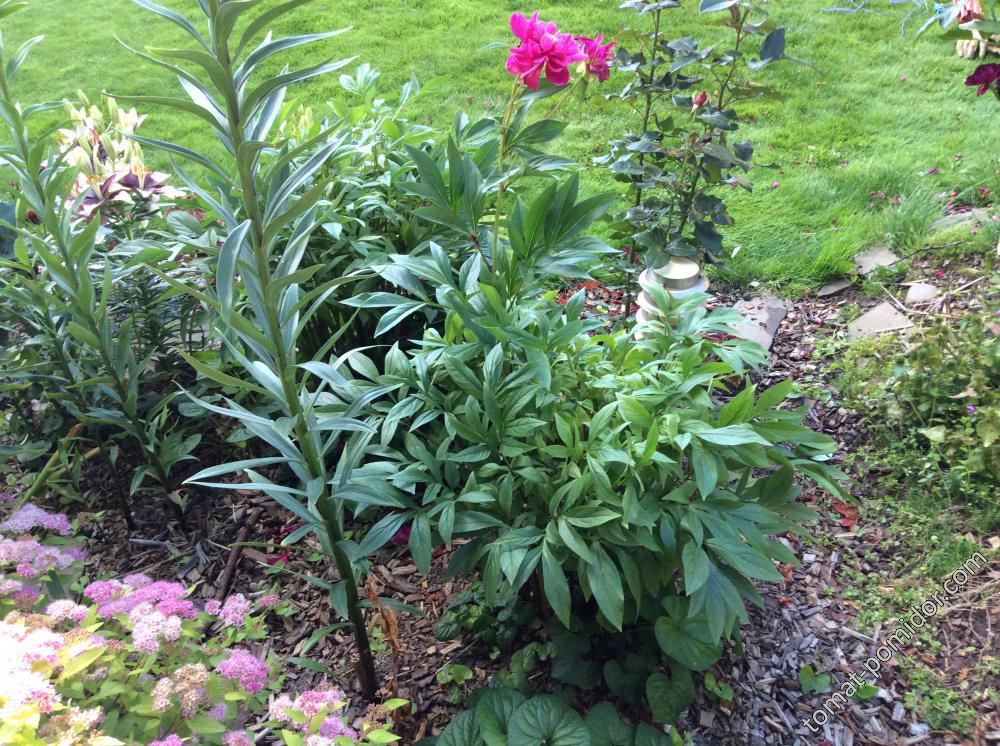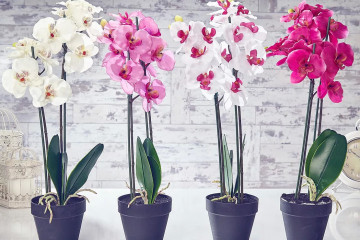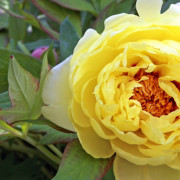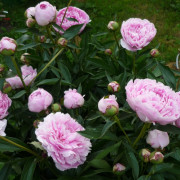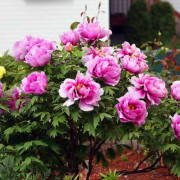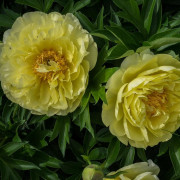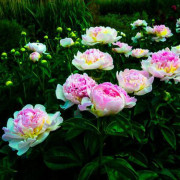Caring for peonies after flowering - how to properly prepare a plant for winter
Content:
Lush flowering and unpretentious care are the main reasons for planting peonies in your garden. In beauty, these flowers are not inferior even to roses, but much less attention is needed to them. But peonies do not bloom so long - only 2-3 weeks, after which they must be prepared for the next season. Caring for peonies after flowering is a complex of measures, the implementation of which will ensure their good development in the future.
Preparing peonies for winter: pruning
During the flowering period, peonies look amazing - lush buds of bright shades of pink cover the entire garden. But when the plant begins to fade, it looks unsightly and is a green bush with narrow, long leaves. Therefore, inexperienced growers make a big mistake - they cut the peony bush almost at the root. The motivation is obvious: the crop no longer looks capable of producing new blooms, so it is better to prune it for the winter. To avoid this mistake, you need to understand how peonies bloom.
Is pruning necessary and why
Plant nutrition is largely provided by photosynthesis that occurs in the green part of plants - the leaves. If you cut them right after the bush has bloomed, the flower will be deprived of energy and nutrition. The accumulation of nutrients becomes impossible, and without them growth buds will not form, from which buds will develop in the next season. Therefore, it is categorically not recommended to carry out thoughtless pruning at the root. If the climate is favorable and the soil is fertile, the bush will survive and may even bloom again. However, the plant will weaken and there will not be as many buds as in the previous time.
First of all, you will need to remove the buds and weak leaves under them. If you do not plan to breed and transplant peonies, you do not need to wait for the formation of a boll on the peduncle.
Pruning in the early years of life
After planting peonies, the florist wants to see the result of his labors as soon as possible - the lush flowering of large buds. However, the first summer the bush should not be allowed to bloom - the buds are cut off immediately after they appear, even before flowering. They do the same in the next season, and only in the third year of life can the peony be allowed to bloom. If you act differently, the bush may not grow strong enough and die in the winter, undergo diseases or give a weak flowering. However, if it is strong, and the climate is favorable, you can try to leave the buds in the second year of the culture's life.
How and when to prune dried buds
When the peonies have faded, what to do next with them is an urgent problem for the grower. It was already explained above that it is by no means possible to cut them at the root, but what are the rules for pruning? The first of them is to remove flowers too early, that is, immediately after the end of flowering, not worth it. You need to wait until all the flowers fall and the last flower withers - then you can start the procedure.
There are three types of peony pruning, each of them has its own goals and is needed for both types of flower (tree and herbaceous):
- Spring. Aimed at strengthening the plant. During this period, the branches that have weakened over the winter are removed.
- After flowering. It is carried out 1-2 weeks after the end of flowering, without it the bush will weaken.
- Pre-winter. Most importantly, pruning allows the peony to build up strength for the next season.
Before freezing, the bush must be prepared, otherwise it will die from exhaustion or weaken.
Spring pruning is carried out in mid-April, its purpose is to form and rejuvenate the bush. Do not be afraid that a strong shortening of the shoots will affect the rate at which the buds appear, because peonies grow very quickly.
Algorithm of the procedure:
- Cut off the twigs and leaves of the second season before the growth node.
- Remove weak shoots, leave literally 10-20 cm of the stem.
- Cut off 1/3 of the buds that appear so that the remaining ones become larger.
- Remove all root growth from the tree peony.
- Trim frozen shoots.
If the bush has been growing for more than 10 years, every spring you need to cut it off dramatically, leaving only 10-15 cm of branches from the ground. For them, removing shoots under the root is useful: this is exactly what experienced flower growers do.
To accurately determine when to prune peonies after flowering, you need to track them. As soon as the new buds stop opening, and the already blooming ones begin to fade, you need to start counting. After 1-2 weeks, pruning can be done by cutting off the flowers. Leaves must not be touched - this was mentioned above.
So that next year the peonies bloom larger, you can leave the upper buds - just a few pieces.
It is very important to collect the fallen petals and leaves at the roots of the bush - they accumulate moisture, creating fertile conditions for the appearance of fungus and mold. After that, the peonies can be left alone until the first frost - at this time, autumn pruning is carried out. The optimal time for her is the end of October or the beginning of November, but not earlier: the roots will not receive the proper amount of nutrients and will weaken. If the place of growth of peonies is a summer cottage, you need to regularly check the bushes so that they are not attacked by pests or diseases during this period.
The autumn procedure is performed according to a certain scheme:
- Cut off the stems with a sharpened garden tool, leaving 4-5 cm above the growing point. The rest of the shoots can be removed, sometimes even at the root, going deeper into the ground.
- Collect trimmed leaves and twigs, carefully checking their presence at the root zone of the bush.
- Cover the place of growth of peonies for the winter with peat or dry humus, the thickness of the protective layer is 10-15 cm. It is not recommended to use dry grass as insulation - it can become a breeding ground for pests.
- Before insulation, you can sprinkle the ground and the bush itself (a little) with wood ash. It is a natural medicine for peony: it heals wounds, nourishes and disinfects.
After the peonies are pruned after flowering, they need special care. It differs from the recommendations during flowering, because the lion's share of nutrition during this period goes to the buds.
Pruning a tree peony
For tree-like peonies, the general rules for pruning are the same as for herbaceous ones, the only difference is that dry and damaged shoots are not removed, but left until the spring months. In the spring they are cut to the first bud, forming a peony bush. Every 20 years, rejuvenating pruning is carried out, cutting off branches almost to the root. If this is not done, the side shoots will not wake up and blossom.

For tree peonies, only autumn pruning is slightly different, after flowering, the removal of buds is also carried out
Pruning errors
Peonies bloom so beautifully that it is difficult to resist the temptation to cut the bouquet. This negatively affects the condition of the bush, because not only the buds are removed, but also the foliage with stems.Pruning earlier or later than a certain period will also be a mistake. Peonies cannot be pruned in August when flowering is still ongoing, unless it is a cold climate.
Cessation of watering and autumn feeding
From May to August, peonies require a lot of nutrients (peak flowering occurs in June and July) to keep their buds healthy. In autumn, however, the need for feeding decreases markedly, gradually reducing to a minimum. The same applies to watering, but its frequency should be reduced more gradually. All the forces of the plant are aimed at strengthening the root system and the formation of buds. If you leave it for this period without support and do not feed it, you should not wait for flowering next year.
Role of micronutrients
Organic fertilizers can not be applied at all, unless the soil is too poor in nutrients, it is better to focus on mineral fertilizers. You can also fertilize with bone meal, superphosphate and potassium nitrate. Foliar dressing will help give the bush a great decorative effect for the next year. 2-3 weeks after the petals fall from the buds, you can feed the plant with a mineral and organic mixture:
- potassium nitrate and superphosphate in a ratio of 1 (1.5): 2 per bush (no more than 20 g of superphosphate);
- mullein solution in a ratio of 1 to 10 with water - 2-3 liters per bush.
It is very important to apply fertilizers not to the rhizome itself, but to the grooves at its base (they are made independently). It is necessary to feed peonies until the end of flowering.
It is also necessary to treat the bush against fungal diseases. For these purposes, copper oxychloride is suitable.
The best nutrition for the autumn period for peonies will be useful substances from the leaves, which will remain after proper pruning.
Watering rules
Some growers believe that as soon as the peony has bloomed, you can stop watering - you don't need to spend energy on flowers. This can be called a mistake, because the bush needs moist soil to form buds. Therefore, it is necessary to water in the autumn, just the volume needs to be gradually reduced. For example, if usually 20 liters of water was added under the bush, it is necessary to reduce the volume to 15 liters, then to 10 liters, and so on. If the summer is dry, you can reduce the water supply less intensely.
When watering, the soil must get wet to a depth of 30-40 cm, the water must get to the roots - but not flood them! The stronger the root system, the better the bush will endure the winter. Watering stops by the end of autumn, when the buds are formed, and the plant enters the resting phase.
Loosening and mulching the soil
Loosening the soil is a useful technique in caring for peonies, especially after rains. Heavy soil dries out from above in a thin layer that does not allow air and sunlight to pass through, impairing the permeability of the soil. Therefore, it is necessary to loosen the ground regularly, after watering or rainstorms - open ground allows the necessary substances to pass better.
Mulching for peonies will allow you to better prepare them for winter, providing them with food and warmth. As this material, you can use humus, dry mullein. If this layer is moistened, it will begin to decompose on its own, which will provide additional nutrition for the root system.
Features of preparation for winter, depending on the region
If the peonies are not covered for the winter, the buds and roots may suffer from the cold. This is especially true of Siberia and the Urals, where the temperature in winter is very low, and there is a lot of snow. Mulching is necessary, its height should be at least 8-10 cm. Its volume is 8-10 liters per bush, the material is decomposed loose compost, deoxidized peat (you can buy in a professional gardener's store) and earth. Also on top, some growers cover peonies with buckets and cardboard boxes.
If the winter is not very snowy, but cold (middle zone of Russia), the shelter can be made not so solid. It is very useful to add sand before the mulching layer - about a shovel on a bush. But only they cannot shelter for the winter - it does not retain heat well.
If winters in the region are snowless, as in the south, mulching must be performed.
Peonies are brightly flowering plants, they are known for their unpretentious care. In order for them to please with lush flowering every year, you need to properly care for the bush, namely, to carry out the correct pruning. If you do all three stages of the simple procedure correctly, the peony bush will delight the grower for many years.

